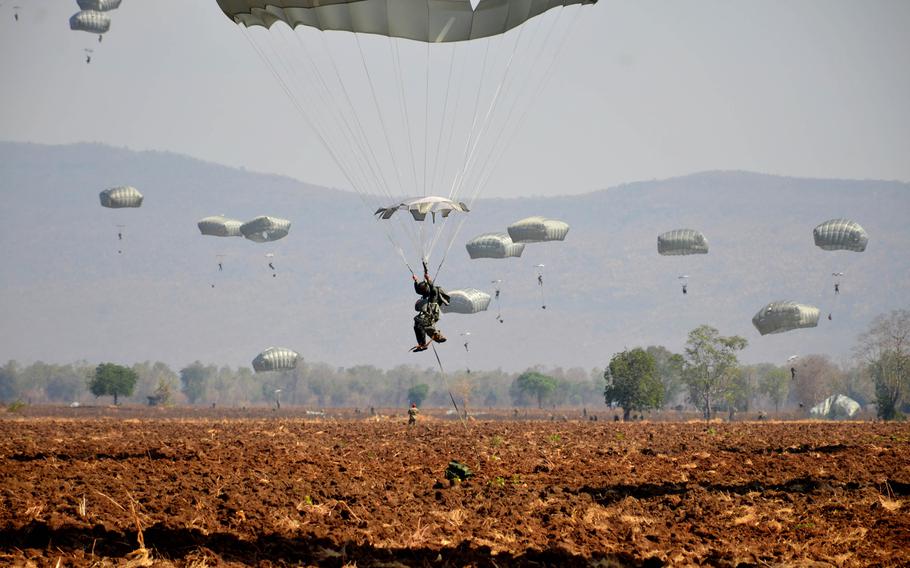
A Thai paratrooper prepares to land in central Thailand, March 5, 2024, during the Cobra Gold exercise. (Alex Wilson/Stars and Stripes)
LOPBURI, Thailand — Sweaty, tired and dehydrated, more than 100 U.S. paratroopers from Alaska sought refuge this week in what little shade they could find on nearly barren farmland in central Thailand.
An hour earlier, the paratroopers of the Army’s 11th Airborne Division from Alaska and their Thai counterparts had jumped from a pair of U.S. Air Force C-17 Globemasters.
The airborne jump was part of Cobra Gold, the largest military exercise in mainland Southeast Asia and the longest-running exercise in the world.
Held annually since 1982, this year’s drills brought 4,500 U.S. service members together with troops from host nation Thailand and 30 other countries, including Indonesia, Japan, Malaysia, Singapore and South Korea. The two-week exercise concludes Thursday.
Some of the U.S. troops made the jump after a 17-hour direct flight from Alaska. Others gathered earlier in the day at U-Tapau, about 250 miles south of the jump zone.
Spc. Ole Cruz, who flew in from U-Tapau, walked away from his landing with a rolled ankle but otherwise unscathed. During his descent, winds pushed him into a tree and then into a truck.
“It’s not a common issue, but it happens every once in a while,” he told Stars and Stripes.
Those who flew directly from Alaska began their journey in single-digit, low-humidity sub-Arctic cold; they arrived in Thailand to nearly 100% humidity and temperatures close to 100 degrees Fahrenheit.
“We’re highly suspecting heat injuries being the primary injury that we see out here — dehydration, heat exhaustion or just the lack of acclimatization,” Staff Sgt. Klay Allen, a medic on the ground, said just before soldiers began jumping. “We’ve been here for a little over a week, and we’re still sweating — it’s just overly hot here for us.”
Once on the ground, the troops gathered their parachutes and walked to their posts, in some instances a mile from their landing zone. After checking in with their command posts, they took positions and prepared for an M119A3 howitzer live-fire demonstration.
Some paratroopers reported immediately to medical tents to be treated for heat illnesses or minor injuries. Throughout the day, Thai military ambulances drove away with the serious cases.
Most soldiers, however, moved forward with the demonstration. Those assigned to fire the howitzer were routinely rotated out with others waiting in the shade of the few trees in the area.
Wherever they waited in the intense heat, they reminded one another to drink water.
“There’s some risk mitigation that we have to do to watch out for heat injuries,” said Capt. Justin Atkins, commander of a howitzer battery. “But most importantly, it demonstrates that we are able to do what we do in any condition.”
Some troops said plowed farmland dried to a rocky surface isn’t an ideal landing zone, but the exercise affords real-world experience.
“This exercise here helps us build more platoon readiness — making sure that our whole platoon and even our whole battery [is ready],” said Sgt. Stephen Suber, a howitzer gunner.
“It helps the battery really see how ready we are for whatever step the world takes next,” he said. “I think this exercise really helps us see what we need to work on and what we can sustain.”